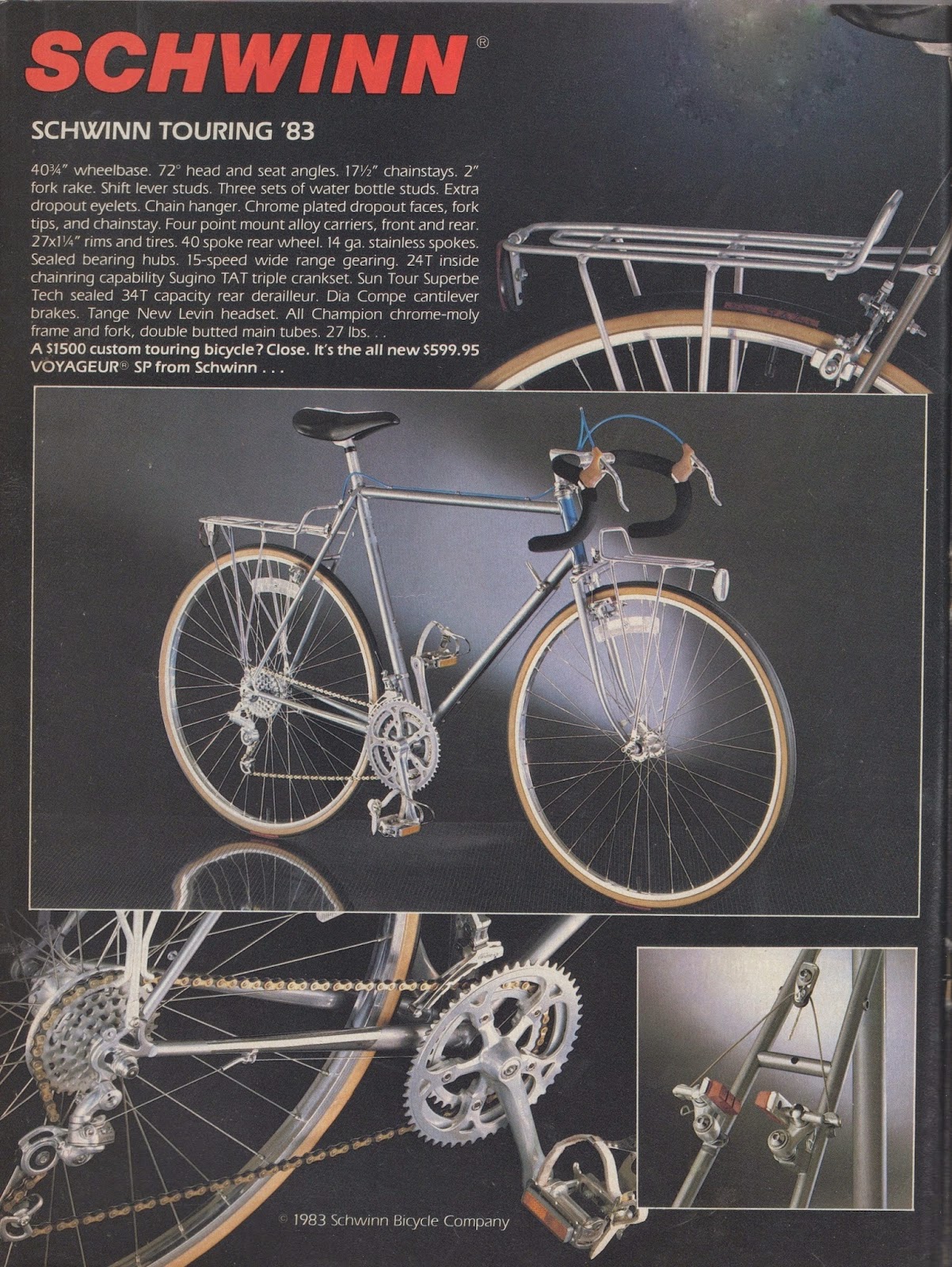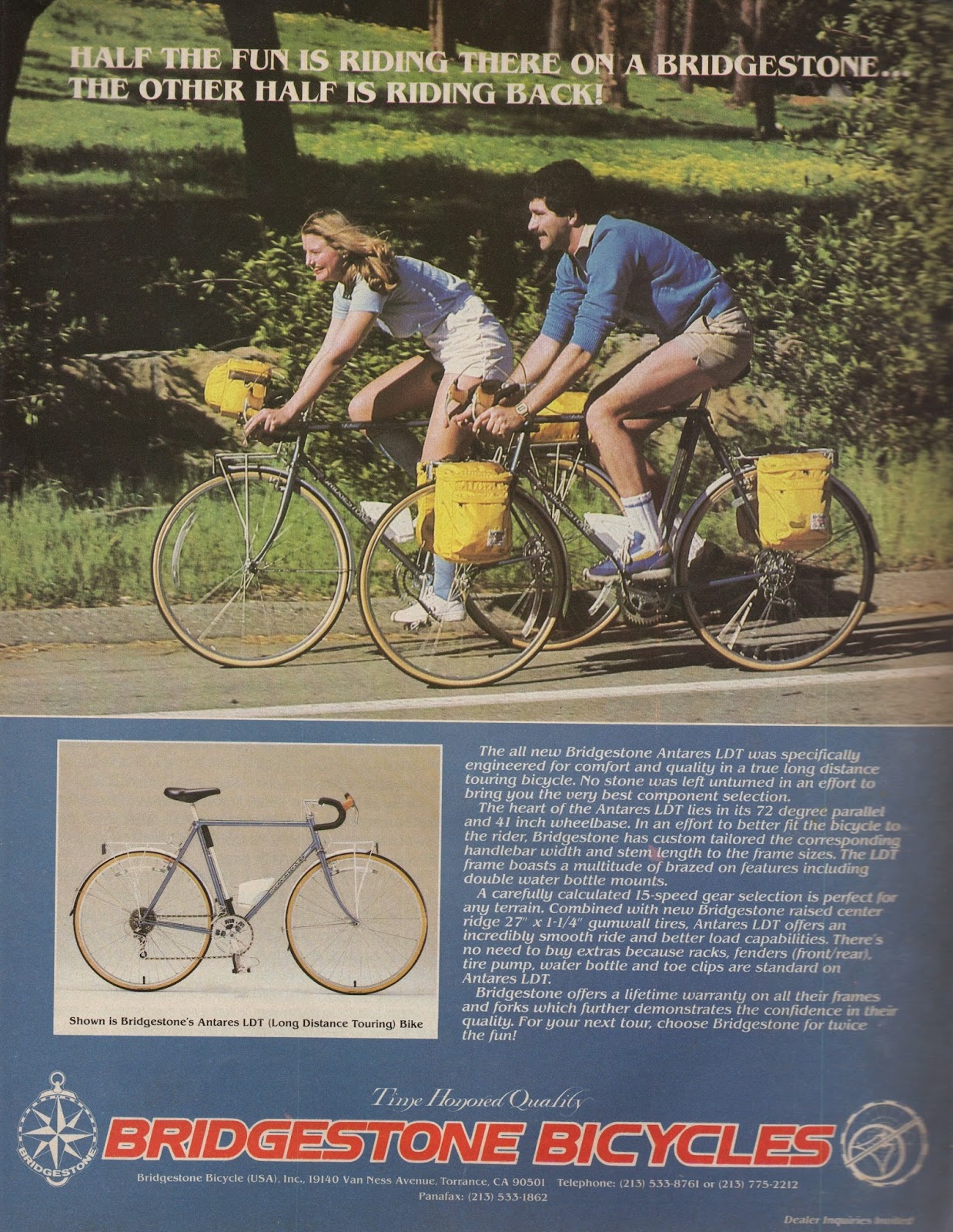There was a time when well-designed loaded touring bikes were all the rage. If you flipped through the bike magazines in the early 80s, it seemed that most -- or at least a pretty large percentage -- of the ads were either for touring bikes, or for touring racks, bags, or other related accessories. In a lot of ways, touring bikes were perhaps more popular than racers. Of course, in the '70s there was less of a difference between the two, as racing bikes back then had much longer wheelbases and more tire clearance than they do now. But by the early 80s, there were all kinds of fully equipped tourers on the market. Recently I posted a scan of a 1979 ad for the
Miyata Gran Touring bike, which was one of the first of its type from the Japanese makers. It was ready for serious touring right from the factory and needed very little before one could take off cross-country. It didn't take long before many other manufacturers were following suit with bikes that were ready for touring right off the showroom floor. Take a look at a sampling of what was available in the early 80s.
![]() |
| From the Miyata catalog. Their model 1000, aka Gran Touring, was the top of the line and one of the best off-the-rack touring bikes around. All it needed was bags and fenders. Miyata was well known for their quality construction -- the lugwork was simple and clean. They also made bikes for the brand Univega, so one can sometimes find a pretty comparable touring bike with that name when searching the vintage bike market. |
![]() |
| Centurion's Pro Tour was another high-quality Japanese-built tourer. It had a good quality lugged chrome-moly frame with clean brazing, and good high-end touring components of the day. And look at that price! (it was 1982, but still. . .) A strong dollar, weak yen meant you could buy some amazing quality in those days. |
![]() |
| Schwinn sometimes gets snubbed by serious bike enthusiasts (their Paramount excepted) -- but they had some pretty nice enthusiast-quality bikes, and I've always had a soft spot for them. One of my first good bikes was a Schwinn Super Le Tour. This Voyager SP was almost certainly built in Japan (except for the Paramounts, a lot of the lugged and brazed Schwinns at that time were built either by Bridgestone or National/Panasonic in Japan). The Voyager SP had a nice chrome-moly frame, lots of braze-ons, racks, cantilever brakes, 40-spoke rear wheel, and some pretty serious componentry. Look closely and you'll see that it also came with the really unusual SunTour Superbe Tech rear derailleur -- which was an expensive, beautiful, over-designed derailleur that was supposed to be a revolution, but unfortunately turned out to be deeply flawed in reality -- too complicated for its own good. |
![]() |
| I'm not sure that Shogun made that big of an impact on the American market, but they were another Japanese manufacturer that turned out some pretty well-made bikes. The frames on these had some features that one wouldn't even find on European-built bikes costing twice as much. Look closely at the seat lug with its reinforced bolt-clamp ears -- solid, not "stamped." No ham-fisted mechanic would be crushing that seat binder. Again -- well equipped for loaded touring, and it even came with fenders! |
![]() |
| Here's one from Bridgestone in the days before Grant Petersen got involved with the company. In the 70s, Bridgestone was selling bicycles in the U.S. under the Kabuki name (a lot of those weren't so great) along with making some bikes for Schwinn. By the early 80s, they were making some decent bikes with their own name on the frame. Their Antares LDT (long distance tourer) was particularly nice -- fully-equipped with racks, fenders, and good quality components. Later replaced by the model T-700, and later again by the RB-T in the Petersen years. |
![]() |
| Not to be outdone, Trek made a really sweet loaded tourer right here in the U.S. with their 720 model, and a somewhat less expensive model (but still very nice), the 520. It featured a high-quality lugged-steel frame made of Reynolds 531 with an extra-long wheelbase, and top-notch components. Note that the one in the catalog was even equipped with a Brooks leather saddle. The only way to get a nicer touring bike than the Trek was to have a custom builder make one for you. |
![]() |
Today's Trek 520 has a welded frame, unicrown fork, sloping
top tube, threadless stem, and v-brakes. At least they brought
back the vintage-looking graphics. Probably a decent bike,
but as far as I'm concerned, it has no soul. |
Of course, some loadable touring bikes are still made today -- but to my mind, there is no comparison between old and new. For example, Trek still makes the 520 touring bike, and it's still built with a steel frame. But now it's welded, with a sloping top tube, threadless stem, and a unicrown fork. Given the choice between any of the tourers made today and a vintage example like the ones shown above, I'll take the old classic without hesitation. Classics from the 80s still come up on eBay and many can be had for bargain prices. In some cases, a person could get a vintage lugged steel beauty, get the frame powder coated (if it's looking worn) and update any worn components, and
still come in under the price of some of the new generation of touring bikes. Which would
you choose?






